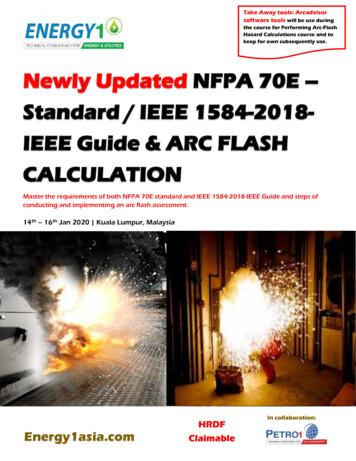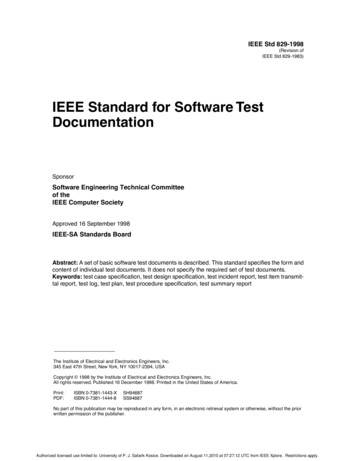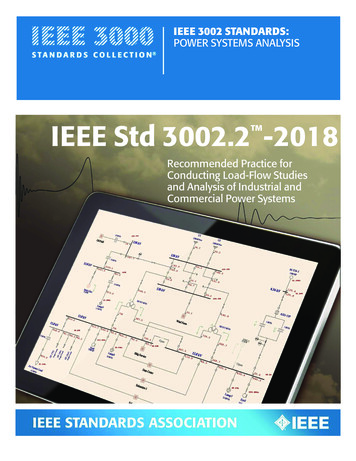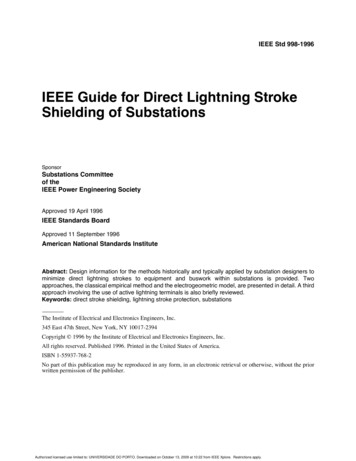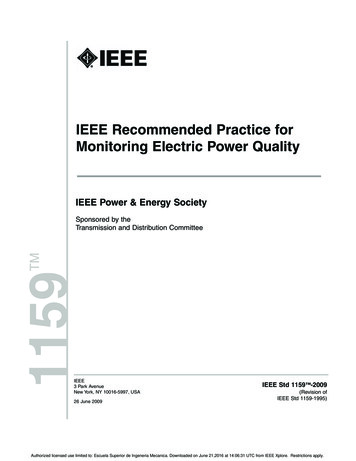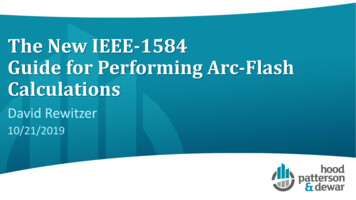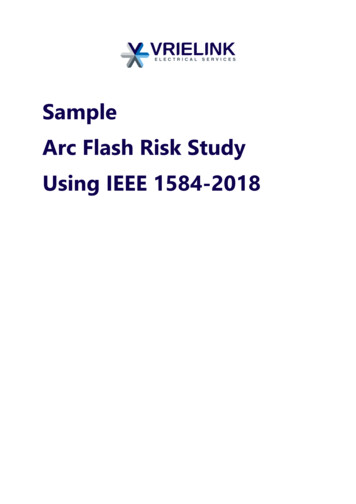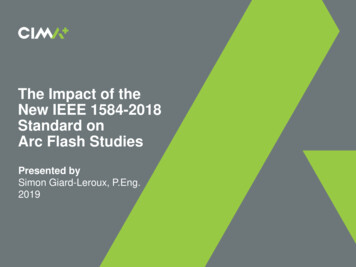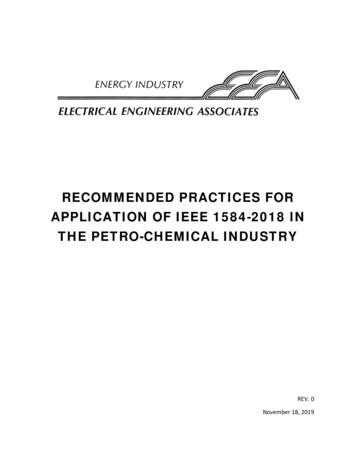
Transcription
IEEE Guide for the Specification ofScope and Deliverable Requirementsfor an Arc-Flash Hazard CalculationStudy in Accordance withIEEE Std 1584 IEEE Industry Applications SocietySponsored by thePetroleum and Chemical Industry CommitteeIEEE3 Park AvenueNew York, NY 10016-5997USAIEEE Std 1584.1 -2013Authorized licensed use limited to: Memorial University. Downloaded on August 01,2014 at 06:55:33 UTC from IEEE Xplore. Restrictions apply.
Authorized licensed use limited to: Memorial University. Downloaded on August 01,2014 at 06:55:33 UTC from IEEE Xplore. Restrictions apply.
IEEE Std 1584.1 -2013IEEE Guide for the Specification ofScope and Deliverable Requirementsfor an Arc-Flash Hazard CalculationStudy in Accordance withIEEE Std 1584 SponsorPetroleum and Chemical Industry Committeeof theIEEE Industry Applications SocietyApproved 11 December 2013IEEE-SA Standards BoardAuthorized licensed use limited to: Memorial University. Downloaded on August 01,2014 at 06:55:33 UTC from IEEE Xplore. Restrictions apply.
Abstract: Guidance for the specification and performance of an arc-flash hazard calculationstudy, in accordance with the process defined in IEEE Std 1584 , is provided in this document. Itoutlines the minimum recommended requirements to enable the owner or its representative tospecify an arc-flash hazard study, including scope of work and associated deliverables.Keywords: arc fault currents, arc-flash boundary, arc-flash hazard, arc-flash hazard analysis,arc-flash hazard marking, arc in enclosures, arc in open air, bolted fault currents, electricalhazard, IEEE 1584.1 , incident energy, protective device coordination study, short-circuit study,working distances The Institute of Electrical and Electronics Engineers, Inc.3 Park Avenue, New York, NY 10016-5997, USACopyright 2014 by The Institute of Electrical and Electronics Engineers, Inc.All rights reserved. Published 10 February 2014. Printed in the United States of America.IEEE is a registered trademark in the U.S. Patent & Trademark Office, owned by The Institute of Electrical and ElectronicsEngineers, Incorporated.PDF:Print:ISBN 978-0-7381-8864-5ISBN 978-0-7381-8865-2STD98504STDPD98504IEEE prohibits discrimination, harassment, and bullying.For more information, visit -26.html.No part of this publication may be reproduced in any form, in an electronic retrieval system or otherwise, without the prior written permissionof the publisher.Authorized licensed use limited to: Memorial University. Downloaded on August 01,2014 at 06:55:33 UTC from IEEE Xplore. Restrictions apply.
Important Notices and Disclaimers Concerning IEEE Standards DocumentsIEEE documents are made available for use subject to important notices and legal disclaimers. Thesenotices and disclaimers, or a reference to this page, appear in all standards and may be found under theheading “Important Notice” or “Important Notices and Disclaimers Concerning IEEE StandardsDocuments.”Notice and Disclaimer of Liability Concerning the Use of IEEE StandardsDocumentsIEEE Standards documents (standards, recommended practices, and guides), both full-use and trial-use, aredeveloped within IEEE Societies and the Standards Coordinating Committees of the IEEE StandardsAssociation (“IEEE-SA”) Standards Board. IEEE (“the Institute”) develops its standards through aconsensus development process, approved by the American National Standards Institute (“ANSI”), whichbrings together volunteers representing varied viewpoints and interests to achieve the final product.Volunteers are not necessarily members of the Institute and participate without compensation from IEEE.While IEEE administers the process and establishes rules to promote fairness in the consensus developmentprocess, IEEE does not independently evaluate, test, or verify the accuracy of any of the information or thesoundness of any judgments contained in its standards.IEEE does not warrant or represent the accuracy or content of the material contained in its standards, andexpressly disclaims all warranties (express, implied and statutory) not included in this or any otherdocument relating to the standard, including, but not limited to, the warranties of: merchantability; fitnessfor a particular purpose; non-infringement; and quality, accuracy, effectiveness, currency, or completenessof material. In addition, IEEE disclaims any and all conditions relating to: results; and workmanlike effort.IEEE standards documents are supplied “AS IS” and “WITH ALL FAULTS.”Use of an IEEE standard is wholly voluntary. The existence of an IEEE standard does not imply that thereare no other ways to produce, test, measure, purchase, market, or provide other goods and services relatedto the scope of the IEEE standard. Furthermore, the viewpoint expressed at the time a standard is approvedand issued is subject to change brought about through developments in the state of the art and commentsreceived from users of the standard.In publishing and making its standards available, IEEE is not suggesting or rendering professional or otherservices for, or on behalf of, any person or entity nor is IEEE undertaking to perform any duty owed by anyother person or entity to another. Any person utilizing any IEEE Standards document, should rely upon hisor her own independent judgment in the exercise of reasonable care in any given circumstances or, asappropriate, seek the advice of a competent professional in determining the appropriateness of a givenIEEE standard.IN NO EVENT SHALL IEEE BE LIABLE FOR ANY DIRECT, INDIRECT, INCIDENTAL, SPECIAL,EXEMPLARY, OR CONSEQUENTIAL DAMAGES (INCLUDING, BUT NOT LIMITED TO:PROCUREMENT OF SUBSTITUTE GOODS OR SERVICES; LOSS OF USE, DATA, OR PROFITS;OR BUSINESS INTERRUPTION) HOWEVER CAUSED AND ON ANY THEORY OF LIABILITY,WHETHER IN CONTRACT, STRICT LIABILITY, OR TORT (INCLUDING NEGLIGENCE OROTHERWISE) ARISING IN ANY WAY OUT OF THE PUBLICATION, USE OF, OR RELIANCEUPON ANY STANDARD, EVEN IF ADVISED OF THE POSSIBILITY OF SUCH DAMAGE ANDREGARDLESS OF WHETHER SUCH DAMAGE WAS FORESEEABLE.TranslationsThe IEEE consensus development process involves the review of documents in English only. In the eventthat an IEEE standard is translated, only the English version published by IEEE should be considered theapproved IEEE standard.Authorized licensed use limited to: Memorial University. Downloaded on August 01,2014 at 06:55:33 UTC from IEEE Xplore. Restrictions apply.
Official statementsA statement, written or oral, that is not processed in accordance with the IEEE-SA Standards BoardOperations Manual shall not be considered or inferred to be the official position of IEEE or any of itscommittees and shall not be considered to be, or be relied upon as, a formal position of IEEE. At lectures,symposia, seminars, or educational courses, an individual presenting information on IEEE standards shallmake it clear that his or her views should be considered the personal views of that individual rather than theformal position of IEEE.Comments on standardsComments for revision of IEEE Standards documents are welcome from any interested party, regardless ofmembership affiliation with IEEE. However, IEEE does not provide consulting information or advicepertaining to IEEE Standards documents. Suggestions for changes in documents should be in the form of aproposed change of text, together with appropriate supporting comments. Since IEEE standards represent aconsensus of concerned interests, it is important that any responses to comments and questions also receivethe concurrence of a balance of interests. For this reason, IEEE and the members of its societies andStandards Coordinating Committees are not able to provide an instant response to comments or questionsexcept in those cases where the matter has previously been addressed. For the same reason, IEEE does notrespond to interpretation requests. Any person who would like to participate in revisions to an IEEEstandard is welcome to join the relevant IEEE working group.Comments on standards should be submitted to the following address:Secretary, IEEE-SA Standards Board445 Hoes LanePiscataway, NJ 08854 USALaws and regulationsUsers of IEEE Standards documents should consult all applicable laws and regulations. Compliance withthe provisions of any IEEE Standards document does not imply compliance to any applicable regulatoryrequirements. Implementers of the standard are responsible for observing or referring to the applicableregulatory requirements. IEEE does not, by the publication of its standards, intend to urge action that is notin compliance with applicable laws, and these documents may not be construed as doing so.CopyrightsIEEE draft and approved standards are copyrighted by IEEE under U.S. and international copyright laws.They are made available by IEEE and are adopted for a wide variety of both public and private uses. Theseinclude both use, by reference, in laws and regulations, and use in private self-regulation, standardization,and the promotion of engineering practices and methods. By making these documents available for use andadoption by public authorities and private users, IEEE does not waive any rights in copyright to thedocuments.PhotocopiesSubject to payment of the appropriate fee, IEEE will grant users a limited, non-exclusive license tophotocopy portions of any individual standard for company or organizational internal use or individual,non-commercial use only. To arrange for payment of licensing fees, please contact Copyright ClearanceCenter, Customer Service, 222 Rosewood Drive, Danvers, MA 01923 USA; 1 978 750 8400. Permissionto photocopy portions of any individual standard for educational classroom use can also be obtainedthrough the Copyright Clearance Center.Authorized licensed use limited to: Memorial University. Downloaded on August 01,2014 at 06:55:33 UTC from IEEE Xplore. Restrictions apply.
Updating of IEEE Standards documentsUsers of IEEE Standards documents should be aware that these documents may be superseded at any timeby the issuance of new editions or may be amended from time to time through the issuance of amendments,corrigenda, or errata. An official IEEE document at any point in time consists of the current edition of thedocument together with any amendments, corrigenda, or errata then in effect.Every IEEE standard is subjected to review at least every ten years. When a document is more than tenyears old and has not undergone a revision process, it is reasonable to conclude that its contents, althoughstill of some value, do not wholly reflect the present state of the art. Users are cautioned to check todetermine that they have the latest edition of any IEEE standard.In order to determine whether a given document is the current edition and whether it has been amendedthrough the issuance of amendments, corrigenda, or errata, visit the IEEE-SA Website athttp://ieeexplore.ieee.org/xpl/standards.jsp or contact IEEE at the address listed previously. For moreinformation about the IEEE SA or IEEE’s standards development process, visit the IEEE-SA Website athttp://standards.ieee.org.ErrataErrata, if any, for all IEEE standards can be accessed on the IEEE-SA Website at the following x.html. Users are encouraged to check this URL for errataperiodically.PatentsAttention is called to the possibility that implementation of this standard may require use of subject mattercovered by patent rights. By publication of this standard, no position is taken by the IEEE with respect tothe existence or validity of any patent rights in connection therewith. If a patent holder or patent applicanthas filed a statement of assurance via an Accepted Letter of Assurance, then the statement is listed on theIEEE-SA Website at s.html. Letters of Assurance mayindicate whether the Submitter is willing or unwilling to grant licenses under patent rights withoutcompensation or under reasonable rates, with reasonable terms and conditions that are demonstrably free ofany unfair discrimination to applicants desiring to obtain such licenses.Essential Patent Claims may exist for which a Letter of Assurance has not been received. The IEEE is notresponsible for identifying Essential Patent Claims for which a license may be required, for conductinginquiries into the legal validity or scope of Patents Claims, or determining whether any licensing terms orconditions provided in connection with submission of a Letter of Assurance, if any, or in any licensingagreements are reasonable or non-discriminatory. Users of this standard are expressly advised thatdetermination of the validity of any patent rights, and the risk of infringement of such rights, is entirelytheir own responsibility. Further information may be obtained from the IEEE Standards Association.Authorized licensed use limited to: Memorial University. Downloaded on August 01,2014 at 06:55:33 UTC from IEEE Xplore. Restrictions apply.
ParticipantsAt the time this IEEE guide was completed, the Arc-Flash Hazard Calculations Working Group had thefollowing membership:Daleep C. Mohla, ChairL. Bruce McClung, Vice ChairJim Phillips, Secretary/1584.1 Team Vice LeaderKenneth S. Jones, 1584.1 Team LeaderDaniel AdjeteyJean AyoubJames BabcockIlanchezhian BalasubramanianPirooz BarkhordarLouis BarriosTerry BeckerJames BeyreisJoshua BillmanWaylon BowersRachel BugarisEric CampbellRay CatlettEva ClarkCraig ClarkeD. Ray CrowSteve DittmanMaurice D’MelloDaniel DoanPaul DobrowskyMike DohertyGary DonnerRyan DowneyPaul EatonRakan El-MahayniSteve EmertTim FaberMark FisherFrank FooteRobert FuhrTammy GammonTim GauthierJohn HempsteadDennis HillRobert HughesBen C. JohnsonDee JonesMike LangRobert G. LauWei-Jen LeeKevin J. LippertAlbert MarroquinLarry McGuireJohn McQuilkinPeter MegnaJames MitchemRoger MorganDean NaylorDennis NeitzelJohn NelsonMike NoonanWheeler O’HarrowSer
IEEE Std 1584.1 -2013 IEEE Guide for the Specification of Scope and Deliverable Requirements for an Arc-Flash Hazard Calculation Study in Accordance with IEEE Std 1584 Sponsor . Petroleum and Chemical Industry Committee . of the . IEEE Industry Applications Society . Approved 11 December 2013 . IEEE-SA Standards Board


